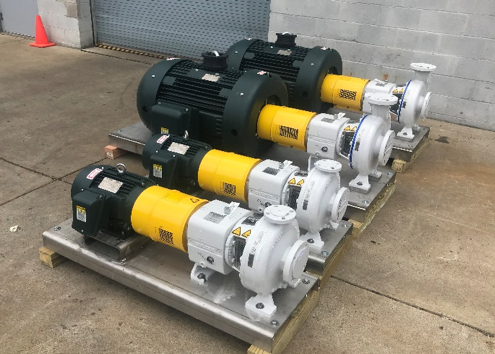
At some point along the way, you’ve probably said that a vehicle was “too much car” for what you need or that a building in that beautiful subdivision was “too much house.” As a user of pumps and pumping systems, you should know you can have “too much pump” for a given application, and the consequences can be expensive and unsafe or dangerous.
Specifically, having a pump that’s too powerful for your environment can create issues related to operating efficiency, reliability and maintenance that can cost you valuable time and money, as well as compromise worker safety.
That’s where expertise comes in, whether it’s from engineers who design pumps or experts who know the details of what makes pumps and pumping systems most effective. Because centrifugal pumps are the most common type of pumping equipment, this discussion will focus on them. Nevertheless, many of the ideas I’ll share with you can be applied to determining the best positive displacement, air diaphragm, vacuum, self-priming and submersible pumps.
If you’ve had an experience where an expensive pump designed for a 30-year life cycle lasted for just a fraction of that time (5, 10, 15 years), it’s probably because the vendor didn’t have a thorough understanding of your application and did not fully educate you about the pump’s capabilities.
.jpeg?width=300&name=Man%20Driving%20a%20Car%20(for%20Feb%202020%20Blog%20Post).jpeg)
Just Like Driving a Car
When it comes to centrifugal pump design, when the pump shaft spins, it turns the impeller inside the casing, which adds energy (usually heat) into the process fluid. This step allows the impeller to serve as a cantilever that, with the help of a wear ring, seals and bearings keeps pump components in place and prevents fluid from leaking.
.jpeg?width=300&name=Basic%20Efficiency%20Point%20(for%20Feb%202020%20Blog%20Post).jpeg)
Regardless of what you may have experienced, every pump has a Best Efficiency Point (BEP) at which the pump operates with maximum efficiency. You’ll see it when the pump runs smoothly and radial force (force acting on the rotor) is minimal.
As you might imagine, as BEP declines, radial force increases, and that phenomenon can cause problems if speed is about 25% or more than the recommended BEP stated in the technical documentation or operator’s manual.
A pump that operates below its BEP will experience excessive vibration and can “shake itself apart” as the wear rings, seals and bearings fail to perform optimally, resulting in fluid leakages.
It’s as if your car’s wheels are out of balance and a lot of mud is stuck to one of the rims. When you’re diving in the city at 25 mph, you don’t notice the imbalance, but when you get on the highway and are driving 70 mph, you’ll feel vibration from the wheels and shock absorbers until you dare to go faster and exceed the speed limit and potentially wear out at least one of your tires.
In my experience, a mechanical failure of seals is the most common reason for pump downtime. Besides too much vibration, which I mentioned previously, causes include:
- Dry Running. A mechanical seal can easily leak or become damaged if you let your pump run dry. That’s because the seal will dry out and friction will cause heat to accumulate, resulting in damage, thermal shock and a disintegrated seal after as few as 30 seconds of overheating.
- Hammering couplings. Many machines’ components, such as pistons, make a hammering action that can be so intense at times that it produces a lot of movement, causing problems for the entire pump, and especially for the seals.
- Using the wrong seal. It’s important to select the right seal for the pump’s application. Unfortunately, sometimes an engineer selects a less-than-ideal seal for a given pump because he or she doesn’t have a complete understanding of the application. Different pumps require different types of seals, and every seal is made to handle specific types of materials. Thus, a seal designed for use with non-abrasive materials should not be used on a pump that handles abrasives. Such miscalculations lead to errors during installation and cause preventable problems during operation.
- Human error. A variety of missteps by machine operators can cause seals to fail. Not starting up the machine correctly, for instance, can cause the motor to trip and the shaft to twist, resulting in moving parts bumping into each other, reduced bearing wear life and seal failure. Other errors include incorrect installation of the seal, neglecting to clean the area around the seal and a general lack of maintenance. Although it may be surprising to you, oil, dirt and the natural oils present in your fingerprints can damage a seal, so it’s important to know a seal’s tolerances before using it for a given application.
.jpeg?width=345&name=Peformance%20Curve%20(Feb%202020%20Blog%20Post).jpeg)
Graded on a Curve
Looking at the bigger picture, a pump performance curve shows the ideal operating range for a given pump. That information can be found in documentation provided by the manufacturer. The pump curve shows the relationship between flow rate and total head, or total dynamic head, which is the total equivalent height a fluid can be pumped and accounts for friction losses in the pipe.
As a user, all you need to know is that a pump functioning at its BEP maintains the same relationship between flow rate and head.
By using a pump curve as your guide during the selection process and throughout a pump’s operating life, you’ll benefit from:
- Choosing a pump that’s right for your specific application
- Monitoring pump health before a problem becomes severe
- Troubleshooting the piping system or other system in which the pump operates to determine the cause of a problem and a solution to correct it
A typical cause of damaged or malfunctioning pumps is cavitation – the formation of cavities or bubbles in liquid. This condition results from low intake pressure around the impeller or the pump is operating at the high end of its curve. Because the pump pulls fluid so rapidly, fluid pressure drops below its vapor pressure and the fluid can boil, causing intense shockwaves inside the pump, as well as damage to the pump’s impeller and housing.
.jpeg?width=300&name=Faulty%20Maintenance%20Image%20(Feb%202020%20Blog%20Post).jpeg)
Causes of Inefficient Pumping
My experience has taught me that pumps – and centrifugal pumps in particular – operate inefficiently for a handful of reasons.
Backwards Wiring – The direction of the shaft’s rotation should agree with the motor’s wiring. If the motor is improperly wired – a problem my team and I have been asked to correct numerous times – the motor can cause the pump shaft to rotate in the opposite direction it should. Although the pump will still move fluid, it will do so at a fraction of the flow and head rates specified by the performance curve.
Often, electricians will “bump the motor” or provide energy for a split second to ensure that motor shaft rotation agrees with the rotation indicated on the bearing frame or in the operator’s manual. Although many mechanical seal manufacturers design pumping rings to generate flow in either direction of shaft rotation, performance will lag unless wiring is done correctly.
Degraded Shafts & Bearings – In general, centrifugal pump motors synchronize with the electronic current’s frequency, which is typically 60 cycles in the U.S. The frequency is controlled by a variable frequency driver that controls the motor’s rotating speed.
A synchronous (alternating current) motor will “seek” as much current as it needs to maintain its speed. If a shaft or bearing is failing, however, that malfunctioning component exerts drag on the motor, forcing the motor to “eat” more current to maintain the speed for which it’s designed. Likewise, if the bearing is operating sub-optimally, it will take more energy for the pump to achieve the desired flow rate.
Contaminated Lubricant – Industrial equipment is often washed down with water, which can contaminate lubricant and lead to the quick degradation of bearings. It is possible to protect bearings from contamination with labyrinth seals, and it is also important to monitor moisture content in the lubricant to help ensure that a pump performs at top efficiency.
Sub-Standard Impellers & Casing – Pump manufacturers design impellers and casing to various geometries for maximizing efficiency. Erosion and corrosion can change the shapes of impellers and casing – sometimes significantly. Although many pumps are designed to compensate for corrosion, damage beyond those limits can affect operating efficiency.
Some pumps feature enclosed impellers and wear rings, which significantly reduces the probability for erosion and corrosion to occur. Additionally, wear rings serve as “sacrificial components” that prevent recirculation from the high-pressure area of the impeller to the area of low-pressure pump suction.
Likewise, solids contained in fluids flowing at high speed can change the shapes of impellers and casings alike. Increasingly, pump manufacturers have begun to use materials that offer superior resistance to corrosion and erosion. For example, to prevent erosion, slurry pump manufactures offer products featuring extremely hard casing and impeller material or rubber linings.
Absence of a Variable Frequency Drive (VFD) – To help your pumps operate most efficiently, it may be advisable to retrofit pump motors with VFDs which enable motors to use only the energy needed to achieve desired flow when extra power is needed. Thus, instead of throttling the discharge valve, you can change pump motor speed by adjusting frequency, which results in conserving energy. To determine which of your pumps could benefit from VFDs, you should identify pumps that operate with partially closed discharge valves.
Determining which pumps are operating inefficiently can be included in an energy audit. Your power supplier may offer such services for a nominal fee or free of charge. Before hiring a firm that specializes in conducting energy audits, check with your power company. In my experience, you’ll get a comprehensive report at a fraction of the cost compared to using a commercial firm. Another simple approach is have the staff electrician take periodic motor AMP readings during normal operation.
The variables that factor into selecting the right pump for a given application can appear daunting at first. Rest assured, however, that with the right information and proper guidance, you can always make the right decision.
To tell us about your pump-related concerns...

